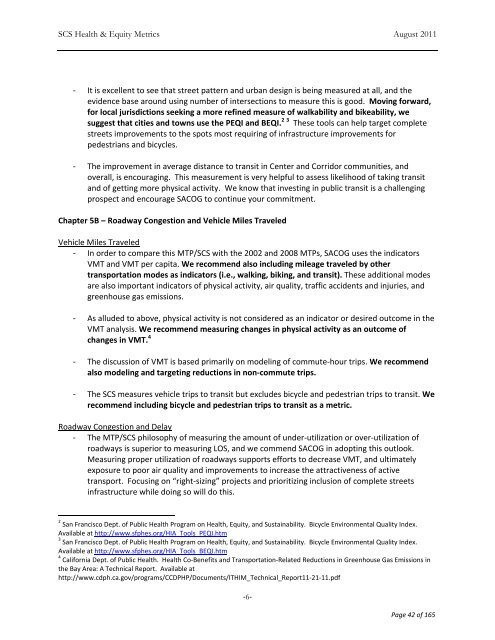Draft MTP/SCS Comments Received - sacog
Draft MTP/SCS Comments Received - sacog
Draft MTP/SCS Comments Received - sacog
Create successful ePaper yourself
Turn your PDF publications into a flip-book with our unique Google optimized e-Paper software.
<strong>SCS</strong> Health & Equity Metrics August 2011<br />
‐ It is excellent to see that street pattern and urban design is being measured at all, and the<br />
evidence base around using number of intersections to measure this is good. Moving forward,<br />
for local jurisdictions seeking a more refined measure of walkability and bikeability, we<br />
suggest that cities and towns use the PEQI and BEQI. 2 3 These tools can help target complete<br />
streets improvements to the spots most requiring of infrastructure improvements for<br />
pedestrians and bicycles.<br />
‐ The improvement in average distance to transit in Center and Corridor communities, and<br />
overall, is encouraging. This measurement is very helpful to assess likelihood of taking transit<br />
and of getting more physical activity. We know that investing in public transit is a challenging<br />
prospect and encourage SACOG to continue your commitment.<br />
Chapter 5B – Roadway Congestion and Vehicle Miles Traveled<br />
Vehicle Miles Traveled<br />
‐ In order to compare this <strong>MTP</strong>/<strong>SCS</strong> with the 2002 and 2008 <strong>MTP</strong>s, SACOG uses the indicators<br />
VMT and VMT per capita. We recommend also including mileage traveled by other<br />
transportation modes as indicators (i.e., walking, biking, and transit). These additional modes<br />
are also important indicators of physical activity, air quality, traffic accidents and injuries, and<br />
greenhouse gas emissions.<br />
‐ As alluded to above, physical activity is not considered as an indicator or desired outcome in the<br />
VMT analysis. We recommend measuring changes in physical activity as an outcome of<br />
changes in VMT. 4<br />
‐ The discussion of VMT is based primarily on modeling of commute‐hour trips. We recommend<br />
also modeling and targeting reductions in non‐commute trips.<br />
‐ The <strong>SCS</strong> measures vehicle trips to transit but excludes bicycle and pedestrian trips to transit. We<br />
recommend including bicycle and pedestrian trips to transit as a metric.<br />
Roadway Congestion and Delay<br />
‐ The <strong>MTP</strong>/<strong>SCS</strong> philosophy of measuring the amount of under‐utilization or over‐utilization of<br />
roadways is superior to measuring LOS, and we commend SACOG in adopting this outlook.<br />
Measuring proper utilization of roadways supports efforts to decrease VMT, and ultimately<br />
exposure to poor air quality and improvements to increase the attractiveness of active<br />
transport. Focusing on “right‐sizing” projects and prioritizing inclusion of complete streets<br />
infrastructure while doing so will do this.<br />
2 San Francisco Dept. of Public Health Program on Health, Equity, and Sustainability. Bicycle Environmental Quality Index.<br />
Available at http://www.sfphes.org/HIA_Tools_PEQI.htm<br />
3 San Francisco Dept. of Public Health Program on Health, Equity, and Sustainability. Bicycle Environmental Quality Index.<br />
Available at http://www.sfphes.org/HIA_Tools_BEQI.htm<br />
4 California Dept. of Public Health. Health Co‐Benefits and Transportation‐Related Reductions in Greenhouse Gas Emissions in<br />
the Bay Area: A Technical Report. Available at<br />
http://www.cdph.ca.gov/programs/CCDPHP/Documents/ITHIM_Technical_Report11‐21‐11.pdf<br />
‐6‐<br />
Page 42 of 165
















